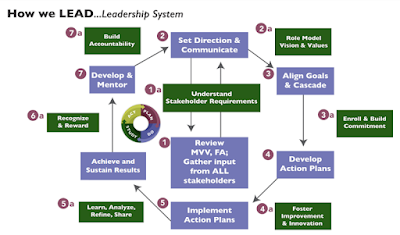Last week in the blog, I mentioned that I had the opportunity to highlight the strength of our leaders and use of the leadership system at the Congress of the American College of Healthcare Executives. When I said I’m extremely proud of our leaders, I truly meant it. Our leaders drove such significant financial improvement throughout the health system last fiscal year, and I want to make sure we sustain this work and don’t lose sight of our quadruple aim of better health, better care, least waste, and more joy.
Embracing the leadership system to inform and empower staff of all levels throughout the organization is the best way for us to achieve our quadruple aim and move faster towards our vision of being the true community-based system of care that treats everyone the way we want our own loved ones treated.
As a refresher, the leadership system is all about using our vision to set goals and build action plans to achieve and sustain results. As part of the process, leaders continuously role model, enroll, improve, reward and mentor the team. You can see the components of the leadership system in the diagram.
Having this formalized leadership system creates a script of what is expected of leaders. When followed, we make great progress.
Brian Riemer, Director of Supply Chain, is a great role model in using the leadership system. The efforts of Brian and his whole team have significantly contributed to achieving and sustaining great results under our Least Waste aim.
Brian and leaders on his team have a strong understanding of our vision, systemwide goals, strategic plan, and how their work ties into each piece. They use their understanding of the big picture to set departmental goals that align with the strategic plan and cascade the goals and information to their teams. This fiscal year, they’ve zeroed in on the Workday implementation, Promise Project, and work around the Lean Management System.
To keep his team enrolled and engaged in progress and tasks required to achieve the goals, Brian holds regular communication meetings with all his staff to cascade information. During the meetings, he reviews the vision dashboard, reminds the team how their work aligns with the strategic plan, and reviews targets to improve. He and his leaders regularly communicate results, explain where they stand on each goal, and clarify next steps with staff.
Not only are logistical, business-related details continuously discussed, but staff is regularly celebrated. Recognition is baked into the culture of the team.
It seems fitting to share that thanks to the work of Brian and his team, healthcare supply chain leader Global Healthcare Exchange (GHX) recently recognized GBMC as one of its inaugural Supply Chains of Distinction Award recipients. GHX has also recognized GBMC multiple times as a “Best 50” healthcare provider for improving operational performance and driving down costs through supply chain automation. These accomplishments have not happened by accident – they have been made possible through dedicated, aligned work cascaded by strong leaders to a fully enrolled and engaged team.
Patient Access Week
Please join me in recognizing our healthcare access professionals in honor of Patient Access Week. GBMC’s Patient Access Representatives are the first points of contact for our emergency department, obstetric, and surgical patients. These team members are responsible for the collection of patient demographic information to ensure accurate patient identification as well as insurance information needed for billing. We could not achieve our vision without the work of our patient access team!
National Public Health Week
This week, we join the American Public Health Association to celebrate National Public Health Week to encourage everyone to work together to make it easier for communities to access the public health resources they need to make their communities healthier, safer, and stronger. The sentiment of the week directly aligns with our commitment to improving population health and access to advanced primary care in the community.


No comments:
Post a Comment
Thank you for taking time to read "A Healthy Dialogue" and for commenting on the blog. Comments are an important part of the public dialogue and help facilitate conversation. All comments are reviewed before posting to ensure posts are not off-topic, do not violate patient confidentiality, and are civil. Differing opinions are welcome as long as the tone is respectful.